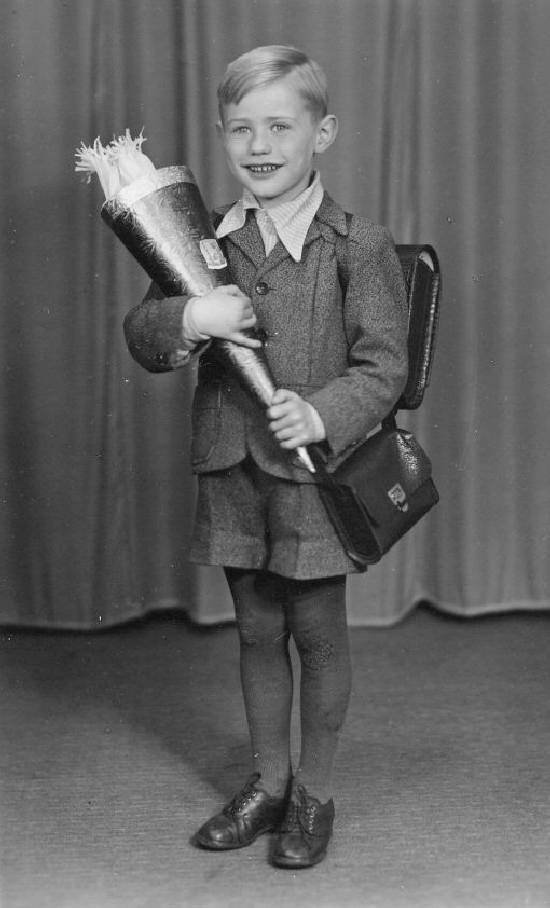
German Personal Experiences: The 1950s

Figure 1.--This German boy wears a new suit for school. This is his first day portrait which you can tell because of the gift cone. He is dressed up in a suit, but this was less cmmon in the 50s as school wear was becoming more informal. We still see long stockings in the early 50s, but they were not very common by the end of the decade, at least in West Germany.
|
|
We have collected a good bit of information on boys clothing during the 1950s. The photographic record and catalogs provide a great deal of information. We see major changes during the decade. Boys in the early 50s continued to wear many old styles that by the end of the decade had largely gone out of style.
We also have acquired information on several individual boys which provide a variety of interesting insights. We see clothing becoming more informal in the 1950s. Boys no longer commonly wore suits to school. We see a range of informal clothes. Many boys wore casual shirts to school with sweaters when the weather got cooler. Boys commonly wore short pants in the early 50s. Lederhosen were popular. We see many boys wearing long pants by the late 50s, especially during the winter. Knee socks also became much less common. We also see teenagers wearing jeans by the late 50s. The German Ecoomic Miracle transformed West Germany. Money was still tight in the early r0s as a result of World War II. By the late 50s, Germans were becoming prosperous, able to afford all kinds of consumer goods, including clothes for thei children.
Gunter Merkel has published a lovely little book about his childhood in Germany--What Life Was Like: Laughs and Reflections (2003). One of the chapters is entitled "Light and Shadows" and includes a personal reminiscence of the author's school days in a Gymnasium. He would have been about 12 or 13 years old at at the time--the equivalent of Junior High School for American children--i.e. about 7th or 8th grade.
This boy and his family is a good example of how rural children dressed in the Post-World war II era. He was photographed in the Black Forrest area about 1953. He looks to be about 8 years old. The boy has a stocking or watch cap with a playful pom. I'm not sure what color it was. He wears a sweater with long short pants, perhaps corduroys, and woolen long stockings. Note the suspenders (braces) that he wears over his sweater. His shoes are hightops which were still common in Germany during the early 1950s--especially in rural areas. In the early 1950s one or two dugout water basins still commonly stood in front of each farm house. Many of these farmers were very well to do, some even rich. Their clothes and their children's clothes wereoften very simple--but commonly sturdy.
A HBC reader tells us, "I was browsing around the Internet the other day and came across an account in German of a guy called Wilhelm (no family name given) who was responding to a blog by a friend who was reminiscing about his boyhood in the late 1940s and early 1950s about having to wear short pants. Wilhelm then responded with an interesting account of his own experience, which I've translated with the help of a dictionary and a colleague whose German is a lot better than mine. Wilhelm appears to have come from a very conservative family."
A British boy has provided us details about his experiences in Germany during the 1950s. "I spent the summer of 1955 in northern Germany, in North Rhine Westphalia, as an exchange student. I was a 16 year old prep school student at the time. I celebrated my 17th birthday there with my German family. I was a junior going into my senior year.
I spent the summer of 1955 in northern Germany, in North Rhine Westphalia, as an exchange student. I was a 16 year old prep school student at the time. I celebrated my 17th birthday there with my German family. I was a junior going into my senior year. [Note for foreign readers: An American prep school is a private school comparable to an English prep school. A junior is an 11th grader and a senior is a 12th grade. After ones senior years, a boy begins university. Almost all prep school boys go on to university.]
These boys are unidentified, but are obviously brothers. They are also clearly German. The image has a photographic stamp on the reverse induicating Berlin, but even without this there would be no doubt that they wee German or Austrian. A photograph collector dates this snapshot of two Berlin brothers to the the 1930s. HBC believes that it is more likely the early 50s. Perhaps our German readers will have some comments. The picture illustrates many popular post-World War II German boys' fashions. Especially the new leather shoes suggest to us that the boys came from a prosperous, but certainly not wealthy middle-class family in a recovering Germany.
HBC

Navigate the Boys' Historical Clothing German pages:
[Return to the Main German personal experience page]
[German choirs]
[German movies]
[German royalty]
[German school uniforms]
[German youth groups]
[German sailor suits]
[Lederhosen]
[Ethnic]
[Tights]
[Long stockings]
Navigate the Boys' Historical Clothing Web Site:
[Introduction]
[Activities]
[Biographies]
[Chronology]
[Clothing styles]
[Countries]
[Bibliographies]
[Contributions]
[FAQs]
[Glossaries]
[Images]
[Links]
[Registration]
[Boys' Clothing Home]
Created: 8:04 PM 6/7/2008
Last updated: 8:04 PM 6/7/2008



